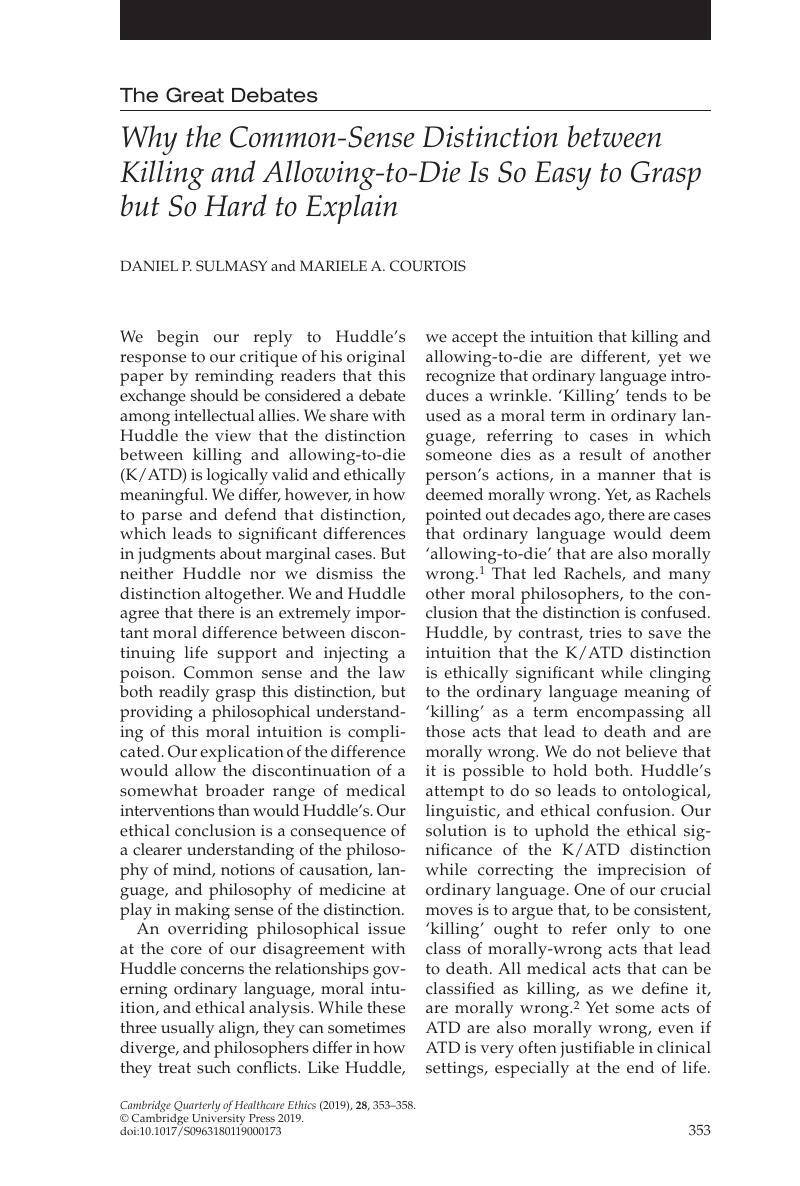Article contents
Why the Common-Sense Distinction between Killing and Allowing-to-Die Is So Easy to Grasp but So Hard to Explain
Published online by Cambridge University Press: 22 May 2019
Abstract

- Type
- Departments and Columns
- Information
- Copyright
- Copyright © Cambridge University Press 2019
References
Notes
1. Rachels, J. Active and passive euthanasia. New England Journal of Medicine 1975;292:78–80.CrossRefGoogle ScholarPubMed
2. We recognize two justifiable casuistic exceptions to the prohibition on killing, self-defense and the defense of innocent victims, but these exceptions are not relevant in the medical context. See Sulmasy, DP. Killing and allowing to die: another look. Journal of Law, Medicine & Ethics 1998;26(1):55–64.CrossRefGoogle ScholarPubMed
3. See note 2, Sulmasy 1998.
4. See note 2, Sulmasy 1998, at 57–8. Emphasis added.
5. See note 2, Sulmasy 1998, at 57–8. Emphasis added.
6. Huddle, TS. Reply to Sulmasy/Courtois: Why it is sometimes unethical to deactivate cardiac implantable electrical devices. Cambridge Quarterly of Healthcare Ethics 2019;28(2):347–52, at 347.Google Scholar
7. See note 6, Huddle 2019, at 349.
8. See note 6, Huddle 2019, at 348.
9. See note 6, Huddle 2019, at 349.
10. See note 6, Huddle 2019, at 350.
11. Sulmasy, DP. Killing and Allowing-to-Die. Vol. 1, 2. Ph.D. diss. Dir. Edmund, Pellegrino. Department of Philosophy: Georgetown University. 1995.Google Scholar
12. Sulmasy, DP. Double effect reasoning and care at the end of life: Some clarifications and distinctions. Vera Lex 2005;6:107–45; andGoogle Scholar Sulmasy, DP. ‘Reinventing’ the rule of double effect. Oxford Handbook of Bioethics. 2009 September;114–48.Google Scholar
13. See note 11, Sulmasy 2005;6:107–45; and Sulmasy, DP. ‘Reinventing’ the rule of double effect. Oxford Handbook of Bioethics 2009 September;114–48.Google Scholar
14. “VP shunts and deep brain stimulators sustain life, if in less immediate ways than life sustaining CIEDs. How might my account construe their removal? In each case the implanted device is conferring life sustaining benefit but also burden. The physicians and their affected patients prefer burden relief to the benefit and proceed with device removal.” See note 6, Huddle 2019, at 350–1.
15. See note 6, Huddle 2019, at 351.
- 2
- Cited by


